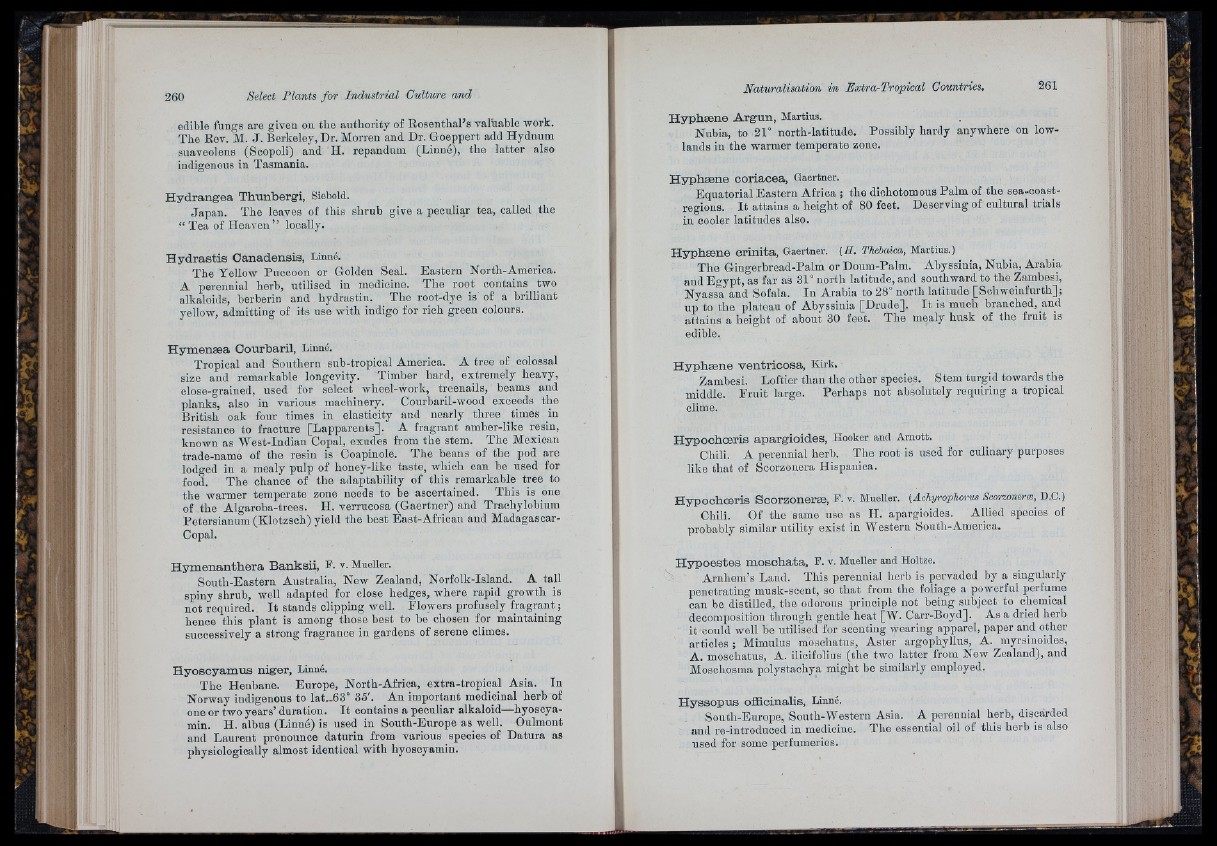
I:-'.: i
260 Select Plants fo r Industrial Culture and
edible fungs are given on tbe authority of Rosenthal’s valuable work.
The Eev. M. J . Berkeley, Dr. Morren and Dr. Goeppert add Hydnum
suaveolens (Scopoli) and H. repandum (Linné), the latter also
indigenous in Tasmania.
H y d r a n g e a T h u n b e rg i, Siebold.
Japan. The leaves of this shrub
“ Tea of Heaven ” locally.
jive a peculiar tea, called the
H y d r a s t is C a n a d e n s is , Linné.
The Yellow Pucooon or Golden Seal. Eastern North-America.
A perennial herb, utilised in medicine. The root contains two
alkaloids, berherin and hydrastin. The root-dye is of a brilliant
yellow, admitting of its use with indigo for rich green colours.
H ym e næ a C o u rb a ril, Linné.
Tropical and Southern sub-tropical America. A tree of colossal
size and remarkable longevity. Timber hard, extremely heavy,
close-grained, used for select wheel-work, treenails, beams and
planks, also in various machinery. Courbaril-wood exceeds the
British oak four times in elasticity and nearly three times m
resistance to fracture [Lapparents]. A fragrant amber-like resin,
known as West-Indian Copal, exudes from the stem. The Mexican
trade-name of the resin is Coapinole. The beans of the pod are
lodo-ed in a mealy pulp of honey-like taste, which can be used for
food. The chance of the adaptability of this remarkable tree to
the warmer temperate zone needs to be ascertained. This is one
of the Algaroba-trees. H. verrucosa (Gaertner) and Trachylobium
Petersianum (Klotzsch) yield the best East-African and Madagascar-
Copal.
H ym e n a n th e r a B a n k s ii, F. v. Mueller.
South-Eastern Australia, New Zealand, Norfolk-Island. A tall
spiny shrub, well adapted for close hedges, where rapid growth is
not required. I t stands clipping well. Flowers profusely fragrant ;
hence this plant is among those best to be cliosen for maintaining
successively a strong fragrance in gardens of serene climes.
H y o s c y am u s n ig e r, Linné.
The Henbane. Europe, North-Afriea, ex tra -tropical Asia. In
Norway indigenous to lat.-63° 35'. An important medicinal herb of
one or two years’ duration. I t contains a peculiar alkaloid—hyoscya-
min. H. albus (Linné) is used in South-Europe as well. Oulmont
and Laurent pronounce daturin from various species of Datura as
physiologically almost identical with hyoscyamin.
■' l;il
H y p h se n e A rg u n , Martins.
Nubia, to 21“ north-latitude. Possibly hardy anywhere on lowlands
in the warmer temperate zone.
H y p h se n e c o ria c e a , Gaertner.
Equatorial Eastern Africa ; the diohotomous Palm of the sea-ooast-
regions. I t attains a height of 80 feet. Deserving of cultural trials
in cooler latitudes also.
H y p h se n e c rin ita , Gaertner. (H. Thehaica, Martius.)
The Gingerbread-Palm or Doum-Palm. Abyssinia, Nubia, Arabia
and Egypt, as far as 31° north latitude, and southward to the Zambesi,
Nyassa and Sofala. In Arabia to 28° north latitude [Schweinfurth];
up to the plateau of Abyssinia [Drude]. I t is much branched, and
attains a height of about 30 feet. The mealy husk of the fruit is
edible.
H y p h s e n e v e n tr ic o s a , Kirk.
Zambesi. Loftier than the other species. Stem turgid towards the
middle. F ru it large. Perhaps not absolutely requiring a tropical
clime.
H y p o o h o e ris ap a rg io id e s , Hooker and Arnott.
Chili. A perennial herb. The root is used for culinary purposes
like th a t of Scorzonera Hispánica.
H y p o c h c e ris Scorzonerse, F. v. Mueller. (Achyrophorus Scorzonerm, D.C.)
Chili. Of the same use as H. apargioides. Allied species of
probably similar utility exist in Western South-America.
H y p o e s te s m o s c h a ta , F. v. Mueller and Holtze.
Arnhem’s Land. This perennial herb is pervaded by a singularly
penetrating musk-scent, so th a t from the foliage a powerful perfume
can be distilled, the odorous principle not being subject to chemical
decomposition through gentle heat [W. Carr-Boyd]. As a dried herb
it could well he utilised for scenting wearing apparel, paper and other
articles ; Mimulus moschatus. Aster argophyllus, A. myrsinoides,
A. moschatus, A. ilicifolius (the two latter from New Zealand), and
Mosohosma polystaohya might be similarly employed.
H y s s o p u s offlcinalis, Linné.
South-Europe, South-Western Asia. A perennial herb, discarded
and re-introduced in medicine. The essential oil of this herb is also
used for some perfumeries.